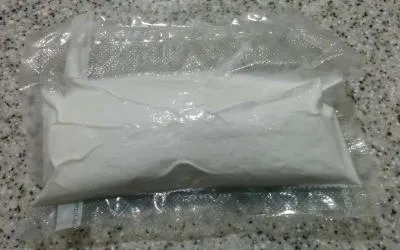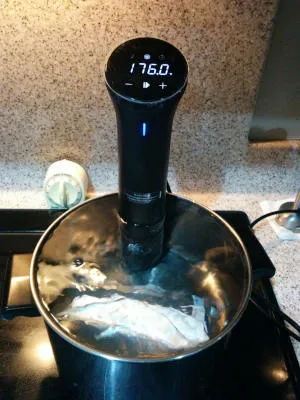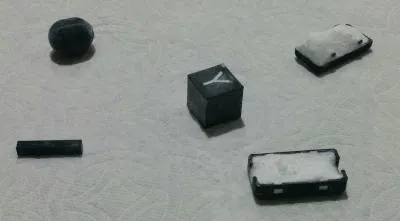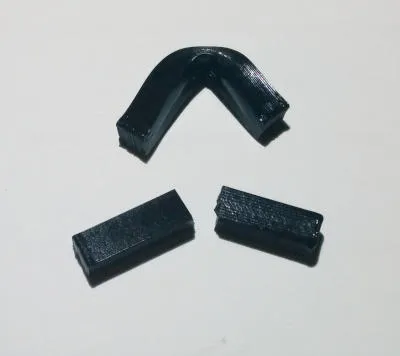Stefan of CNC Kitchen recently posted about annealing (and later re-melting) PLA prints to improve their strength and temperature resistance. I decided to do some experiments of my own.
My method was to print out some PLA objects, pack them in a salt powder that gets vacuum-sealed, and then toss that in the sous vide for 18 hours. The sous vide doesn’t get hot enough to re-melt PLA, so it doesn’t have exactly the same characteristics, but it does gain some benefit. The advantage to the sous vide method is that it’s more available than a constant-temperature oven.
I did informal tests on the annealed prints for a few characteristics:
- Smoothing - did the texture of the print change?
- Strength between layers - was the print any stronger between layers?
- Waterproofing - did the print eventually get waterlogged when placed in water?
- Temperature resistance - did the print get as flexible when subjected to increased temperatures as a non-annealed print?
Procedure
I used four objects: a hollow spheroid, a 30x5x5 mm bar, a calibration cube, and a box with tabs that were oriented perpendicular to the layers. I ground up plain (uniodized) salt in a spice mill, and put that into a FoodSaver bag that was double-sealed at the bottom. Relative humidity when I sealed the bag was around 33%.

I nestled my prints in the salt, then vacuum-sealed the bag and double-sealed the top.

Sealed in the bag. The salt prevented sharp edges from poking holes.
Next, I tossed the bag in a pot of water along with an Anova Nano sous vide stick. I set the temperature for 80 C (176 F) and left it that way for 18 hours.

Cooking at 80 C
After that, I turned the sous vide stick off and let the pot come to room temperature.
Observations
When I removed the salt from the bag, it had formed a solid mass that could be broken apart by hand. I carefully extracted the printed objects. The box lid and letters on the calibration cube letters were packed with salt, but that could be washed out easily.

I measured most of the objects, and found that they had indeed changed size - all were a few percent smaller than before annealing. So I knew annealing did something:
| Original dimension (mm) | After annealing (mm) | Change (as % of original) | |
| Calibration cube X | 20.13 | 19.98 | 99.3 |
| Calibration cube Y | 20.08 | 19.89 | 99.1 |
| Calibration cube Z | 20.15 | 19.98 | 99.2 |
| Spheroid diameter | 20.08 | 19.78 | 98.5 |
| Spheroid height (Z) | 24.82 | 24.72 | 99.6 |
| Bar length (X) | 30.23 | 30.06 | 99.4 |
| Bar width (Y) | 5.14 | 5.06 | 98.4 |
| Bar height (Z) | 5.00 | 4.95 | 99.0 |
Results

Tabs broke off just as easily after annealing
- Smoothing: unlike Stefan’s experiments with PLA re-melting, the annealed objects did not change texture. The plastic still showed the same layer lines and other 3D printer artifacts that non-annealed prints did. I attribute that to the fact that the plastic never flowed - the annealing temperature was always below the melting point.
- Strength: when I assembled the box, the tabs broke off exactly as they had when I printed non-annealed PLA using the “wrong” orientation. I couldn’t measure it, but I don’t think annealed PLA was any stronger between layers.
- Waterproofing: after immersing the spheroid in water for a week, it seemed to sink a little lower, but then stop. I don’t think I’d want to claim that annealing changed the waterproofing of the prints.
- Temperature resistance: this did appear to change. I put both the annealed and non-annealed bar prints on the printer bed at 73 C (163 F). After a few minutes, the non-annealed bar was flexible enough that it could be bent between my fingers. In contrast, the annealed print remained solid, and in fact snapped when I applied more pressure.

The non-annealed part was flexible after heating to 73 C. The annealed part was not.
Conclusion
Annealing sous vide is useful for imparting temperature resistance to PLA, and may be a valuable technique for PLA objects that need to live in a hot environment (such as a car in the summertime). Sous vide annealing is easier and more reliable than trying to anneal in a kitchen oven. Annealing alone does not change texture, strength between layers or waterproofing characteristics.